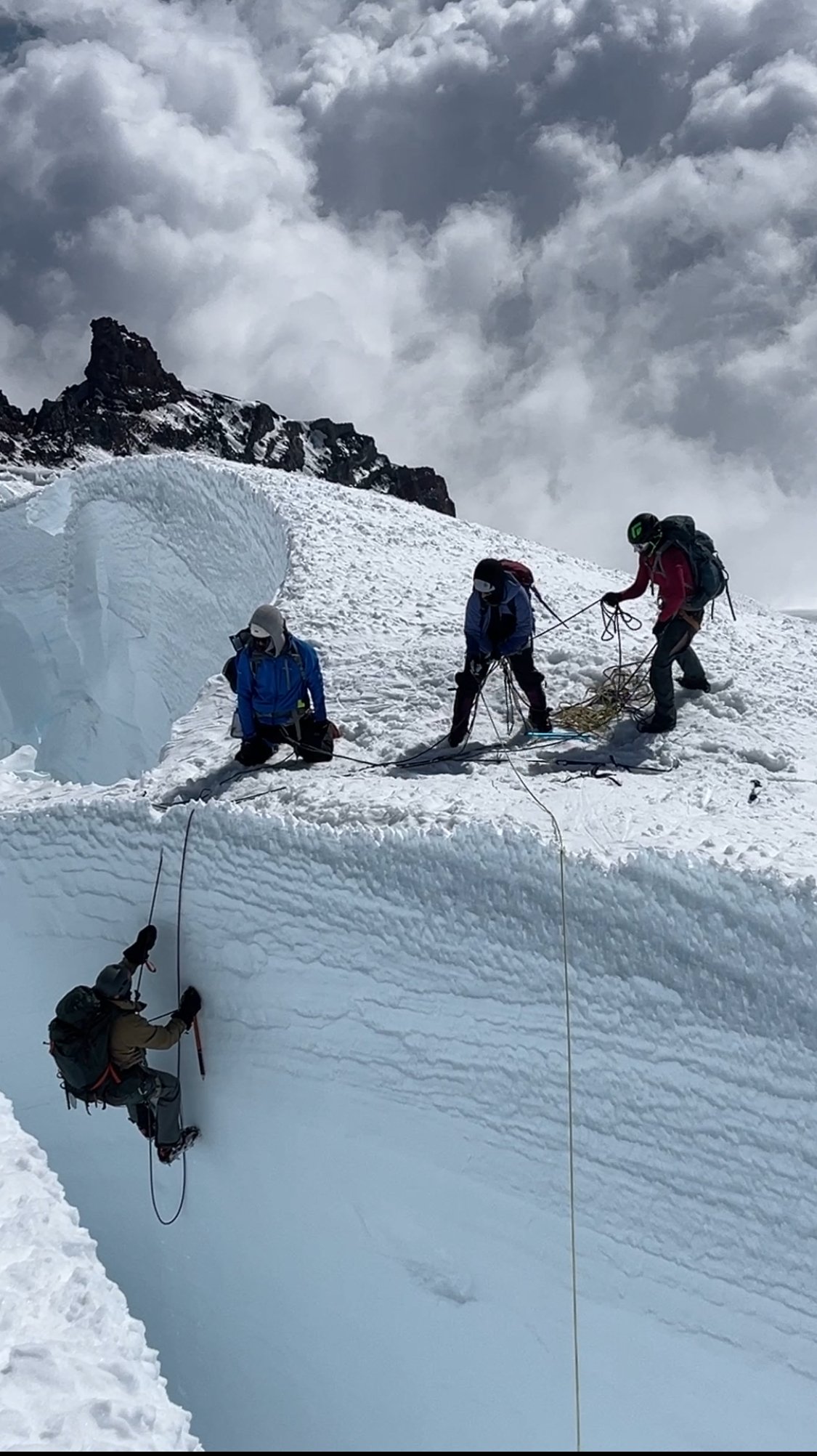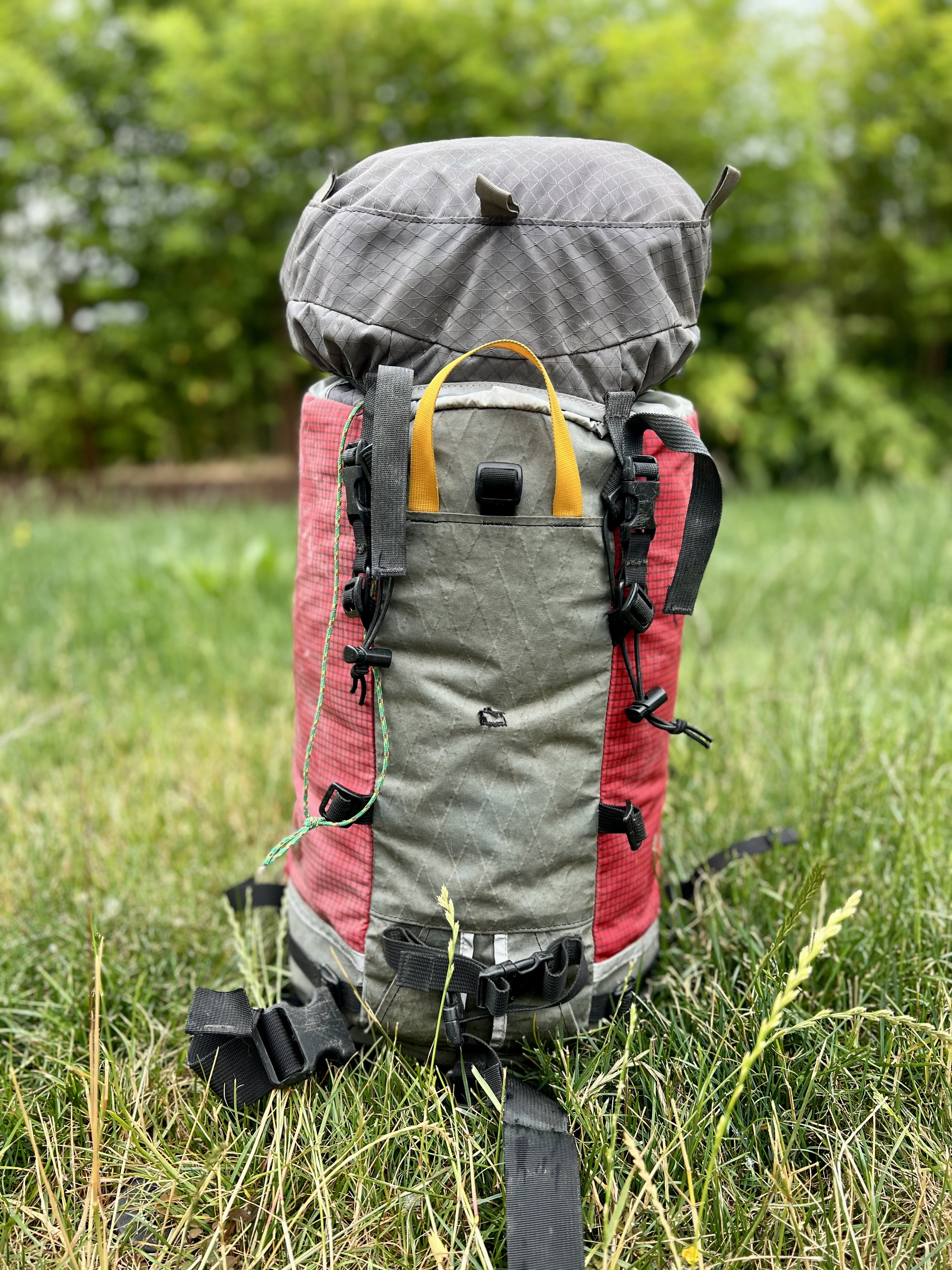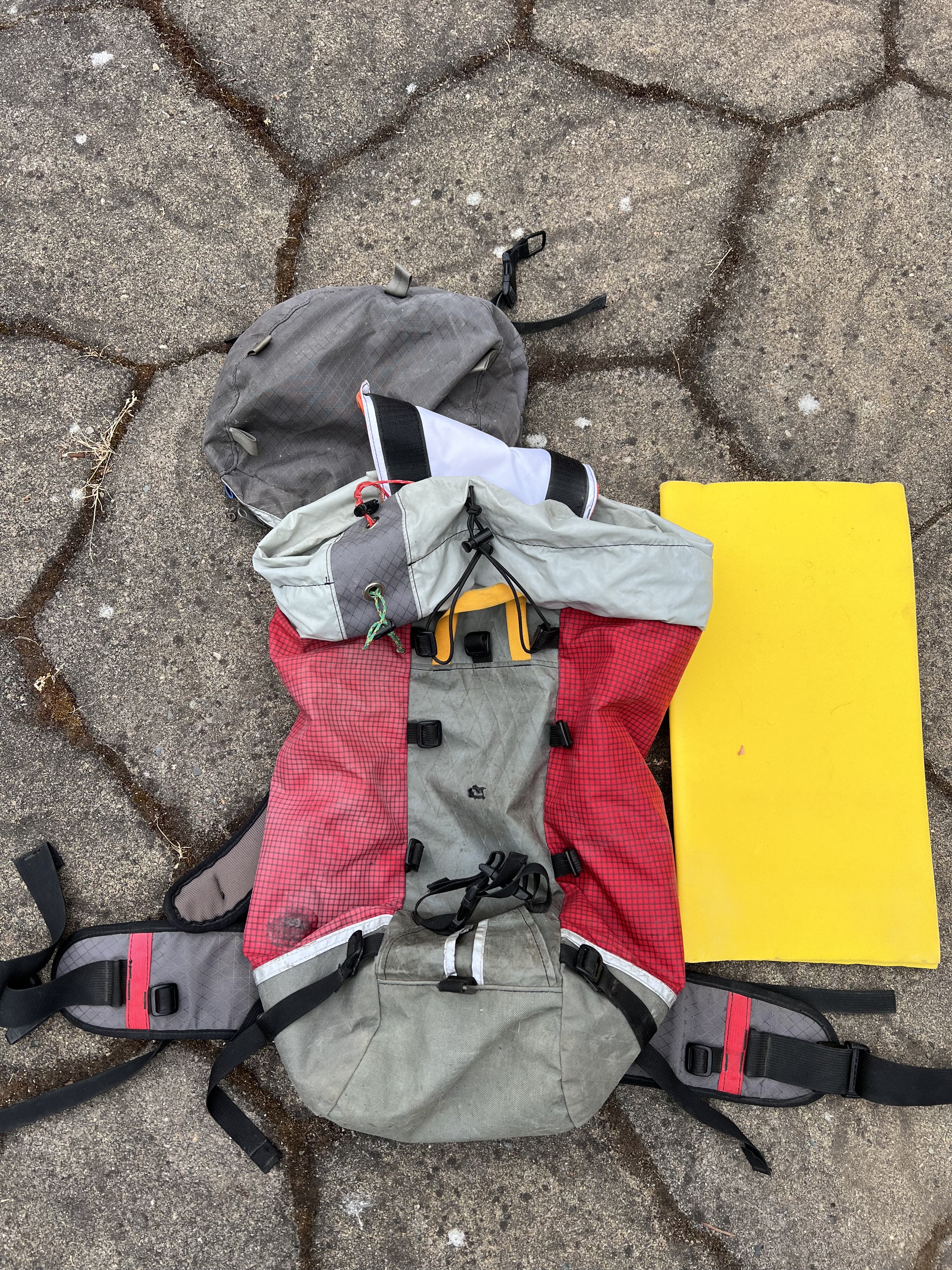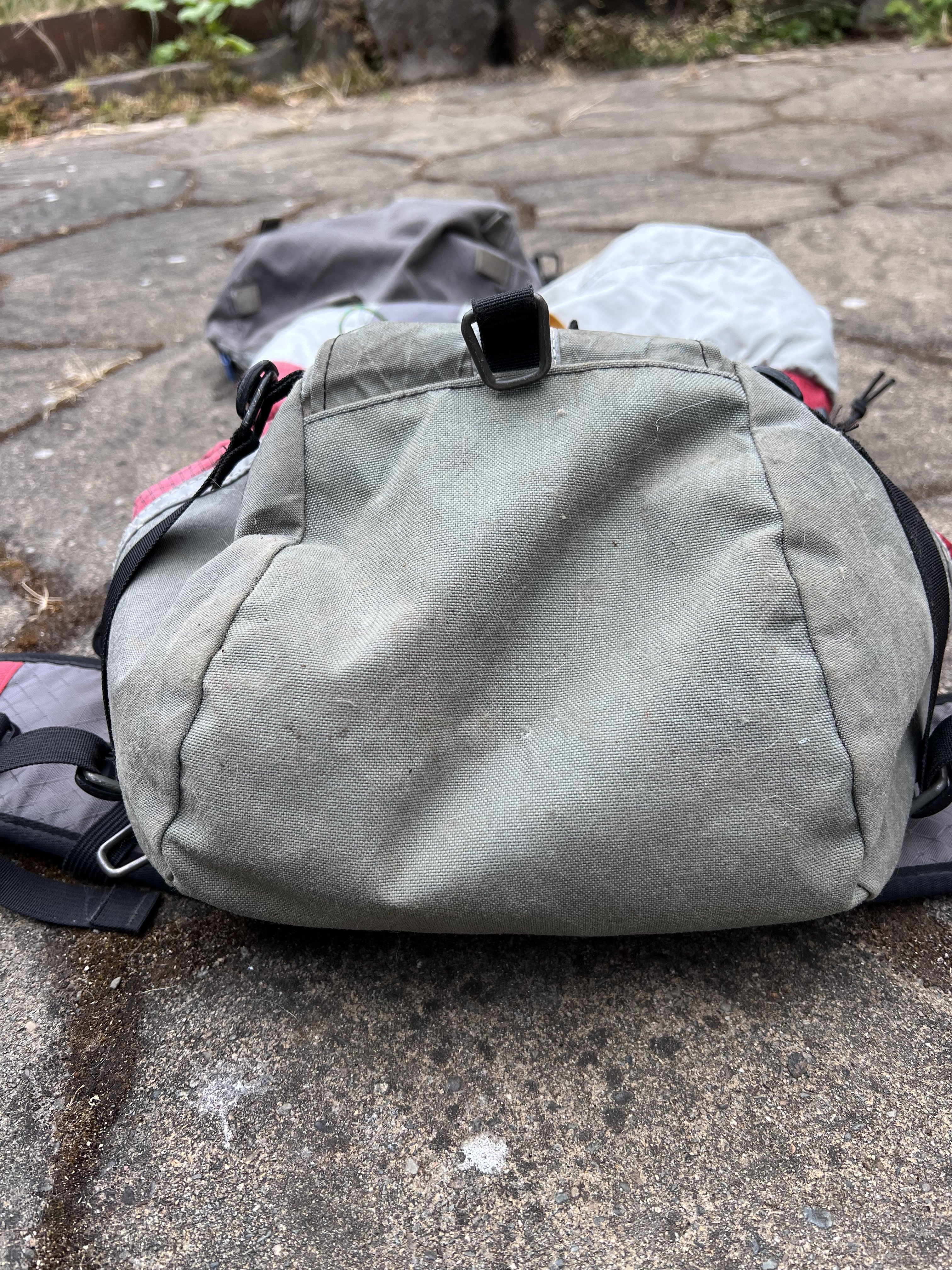All Activity
- Today
-
There are plenty of trip reports out there about the Tahoma Glacier, so I won't elaborate too much on the route. Last year we had planned to climb this route but with a very terrible forecast during our dates we postponed it a year. This year we braved the rain on day 1 in hopes of the promised good weather for summit day. Thankfully it paid off. Leaving the trailhead Saturday morning in the rain. (Photo by my wife) Found fresh snow from the previous night that was now a sloppy mess.....still raining. (Photo by my wife) Rewarded with this view on Day 2. We moved from Camp 1 at 6,200 ft up the Puyallup Cleaver to high camp at 9,800ft at the base of Saint Andrews Rocks. Looking at the Puyallup Glacier. It was well filled in and easy walking up to high camp at 9,800ft. Looking down at the Tahoma Glacier from high camp. You have to drop down the ramp to reach the glacier proper. Sunset at Saint Andrews Rocks at 9,800ft. (Photo by my wife) Early morning crevasse navigation. (photo by my wife) Some more crevasse shenanigans in the broken up sections. More crevasse zigzagging. (photo by my wife) The team nearing the top of the route approaching 14,000ft. The summit with my wife and I. At 13,100 feet on the way down our 2nd person (out of 5) had a sliding fall into a crevasse. I have always said that if you keep your intervals tight you shouldn’t have to worry too much about crevasse falls. And over the last 15 years this has proved true in both the PNW and AK. With multiple small punch throughs over the years nobody has ever gone farther than their armpits. But this time was different. This is because if you punch through a snow bridge you will likely go up to your waist or backpack but then be tight and climb out on your own. I think this is true for typical crevasse falls….bad snow bridge, or winded over crevasse. These are times were you are surprised and fall right in. There is an entirely different type of crevasse fall. This is when you take a fall in steeper terrain and are unable to arrest that fall prior to the crevasse. I never really thought much about this because I feel really confident on crampons and look at those short locations as “do not fall” sections. But clearly with a less experienced group I need to take those sections a little more seriously. Our #2 guy on the rope was very tired on the way down which I am sure contributed to the fall. He fell in just such a place on a traverse above a crevasse on terrain I would call “no fall zones”. He fell off the upper lip and into a big open crevasse. The rope wasn’t super tight but there wasn’t an excessive amount of slack in the system. It was in difficult terrain where there were multiple obstacles stacked right after each other so team members were navigating different technical obstacles all at the same time (not ideal). Looking back I think I could have potentially avoided the incident by the use of running protection. I just felt so secure in those sections that I didn’t really think it necessary. But when taking newer people out it is better to take a couple minutes to add running protection than a hour to pull someone out of a crevasse. Lesson learned for sure, and I am just really glad he was ok. When the fall occurred, my wife who was leading the rope team had just finished all the technical obstacles and was on the lower lip of the crevasse. #2 was working across a traverse 8 feet above the lip of the crevasse and then had a 10 ft down climb to a narrow snow bridge. #3 had just finished a down climb and was just making a step across a thin snow bridge and onto the traverse. #4 was at the beginning of a down climb. #5 (myself) was anchoring the back on the slope above. When #2 fell he was unable to arrest in those 8 feet and so fell off the upper lip. He stopped about 30 feet below the lower lip and just above a sloping snow ledge. The rope never came tight to my wife (#1) because #2 fell towards her creating slack. #3 was pulled off her feet across the snowbridge onto the traverse. She was able to arrest. #4 was pulled off his feet and into the down climb. Myself in the back was able to arrest and hold the fall helped by #3 on the traverse. Thankfully #2 who fell in was uninjured. We were able to give him a little slack so he could get his weight on his feet onto the sloping ledge and then we started working on a plan. It took a bit of time to get things setup since the terrain was complicated where most of the team had arrested the fall. But in the end we were able to get everyone except for myself to my wife's position on the lower lip where there was a great spot for rescue. They were able to equalize 2 pickets (1 deadman and 1 end SLAM) and then used a 3:1 system with an ice ax at the lip to keep the rope up. Once the system was set 2 people were able to haul out the climber in less than 5 minutes. Having various different levels of experience on the team we spent a few minutes afterwards discussing and debriefing the incident. Here were a few lessons people found helpful. Place anchors further from the edge so there is more room to haul. When moving downhill keep walking down past the obstacle (body belay) vs. a hip or ice ax belay. This allows you to quickly run downhill should someone slide towards you creating slack. You need room to walk around at the anchors when performing a rescue. If in a safe spot think about just being out of the system. If not then use cord or the back end of a rope. Both the first 2 rescuers got pretty pinned into short tethers that prevented much movement initially. Have 1 person take lead on patient care and tell the person in the hole to put on warm clothes…even in best case scenarios it is going to be 15-20 minutes in the cold crevasse. If there is a ledge in the crevasse consider giving slack to get the person off the rope and onto their feet. Use the rope for backup should the snow give way again. Think through all the steps that need to get accomplished and try to figure out what can be done concurrently to speed up the process and gain efficiency. Here is the rescue in progress from the top lip of the crevasse at the beginning of the traverse. I ended up be "stuck" on the high side and only helped through directions. I felt the team plenty competent and taking the time to get me to them would just delay pulling out the fallen climber. One more shot as the fallen climber nears the lip. A shot looking up at the top lip of the crevasse and the traverse above. You can see the top of the upper down climb above the traverse on the left. The thin snowbridge is hidden behind the traverse on the left. The final down climb and narrow snow bridge are on the far right after the traverse. The whole incident took about an hour from the time of fall to having everyone out and gathered up at the lower lip. From there we continued down the glacier without further incident. Although people's nerves were a bit shot and any steep terrain encountered further down was negotiated with slow care. This resulted in a very long but safe day. Farther down the glacier at about 11,000ft. We hiked out the next day in beautiful sunshine and tired bodies. But got to see some goats in the process. (photo by my wife)
-
- 1
-

- Yesterday
-
IMG_20250628_110739_4.heic
-
pavelpnw joined the community
- Last week
-
Tate Hughes joined the community
-
Hi everyone! I’m planning a trip to the Waddington Range this August and was looking for the book “The Waddington Guide.” Seems pretty coveted, but if there was one someone was looking to sell, I would be very interested.
-
How much are you wanting for it?
-

"Rescued" While Vlogging on Chianti Spire?
Kameron replied to Fairweather's topic in Climber's Board
Rad is right "Old men yell at young woman" -
I'm a mountaineering guide selling my duplicate climbing gear. This pack has seen summits and valleys and has a lot of life left. A small hole has been patched on the red panel, as shown in the photo. 17.5 length torso. They dont make this pack anymore so jump on this deal. From Cilogear The 3030 Guide Service (GS) Worksack delivers guide-appropriate burliness to a lightweight backpack that excels at 48-hour daytrips. The 3030s are a 40ish liter capacity pack with the suspension of the 30L hence the ridiculous name! The 3030 Guide Service still strips down to a super light summit pack that climbs really well. The same EvaZote foam as in the 30L pads the shoulder straps and hipbelt. This resilient foam cushions your shoulders and hips without weighing you down and provides the best possible load carry. If you know you need more space than the 30L, and you want a burlier pack, the 30:30 Guide Service is the pack for you. A single drawcord extension, the 3030 GS is extremely light. The 3030 includes the hallmark Cilogear features: Ninja Pocket, internal compression strap, removable bivy pad, lid, sternum strap and hipbelt. Volume Range: Normal: 35L | Expanded: 45L | Compressed: 20L | Closed: 10L Weight and Sizing Specifications: Pack bag: 700g(1.6lbs) | Hipbelt: 120g | Lid: 170g | Strap set: 200g | Bivy Pad: 100g | Total: 1290g(2.8lbs)
-
Not sure what the benefits/drawbacks/utility of a detachable penis would be as I haven't given it much thought. There are some questions I'd want answered first.
-
"Rescued" While Vlogging on Chianti Spire?
Fairweather replied to Fairweather's topic in Climber's Board
The KIRO video/original story revealed her to be thoroughly annoying. Came across as narcissist/dismissive. No matter. Welcome to the new era of PNW climbing. Little white squares. -

"Rescued" While Vlogging on Chianti Spire?
olyclimber replied to Fairweather's topic in Climber's Board
Too many clouds for an ol feller to choose -
Well, I was hoping to get others yelling at that cloud but I can see that I've failed. I'll go back to over analyzing some maps tonight.
-

"Rescued" While Vlogging on Chianti Spire?
olyclimber replied to Fairweather's topic in Climber's Board
Back in my day we would have just spit on it and continued up the mountain. Hawk tuah! Kids these days just don’t want to work. Hand me my dentures I’ll show ya. -
Her name didn't come up on an AMGA search of guides, for whatever that's worth. Then I read the article you posted, and it doesn't say she is a guide, only that she was 'leading' three people. Probably just means she has more experience than the others. We've all been there. Punching through a hole is a classic early season hazard that can catch almost anyone off guard, unless you're probing every step, which is completely impractical in the mountains. Vlogging the rescue isn't something I would do, but it isn't illegal and doesn't harm anyone. So yeah, "old man yelling at clouds" here pretty much sums it up. Go out and get some yerselves before yer dead.
-

"Rescued" While Vlogging on Chianti Spire?
dberdinka replied to Fairweather's topic in Climber's Board
Was this person really a "guide"? -
The good thing is that we are all old men here.
-

"Rescued" While Vlogging on Chianti Spire?
dberdinka replied to Fairweather's topic in Climber's Board
-
It is crazy to me the difference in attitude towards rescue today vs. even a few decades ago. Then (90's, when I was a young climber) and now.....I would be so embarrassed/ashamed to be rescued for something like that that I would try and keep it secret, not spread it willingly all over the world! I wonder if she realizes the risks being undertaken by everyone to hoist her for some entirely avoidable error?
-
Damn kids these days!
-
Reebz joined the community
-
Any 2+ available on short notice to take advantage of this upcoming weather window? My partner and I are eyeing the Pickets traverse. We're competent enough to go it alone, but it might be fun to have some company.
-
Ah, thanks so much for pointing me in the direction of someone specific to reach out to, I'll send them a message! Someone's gotta have a copy of that Bryan Burdo book somewhere, I'm looking forward to when one eventually turns up!
-
Check with users Lunger and Sam Boyce. They did something up there last summer? And we’re at the time unaware of the BB lines as well. They may have a copy. Weird how that guidebook seems to have totally vanished. Had all kinds of random Doorish routes and what not in it.
-
Ha!! Yeah, I have sent Bryan himself message, but quite recently though, so I'll give him some time to reply
-
I bet Bryan could hook you up with a copy for the right quantity of raw beef.
-
Thanks! Yeah, I am already aware that a 1997 out-of-print guidebook mentions the overall buttress. I have been able to find that one of the routes in it was named "Archer", and that route is completely distinct from what we climbed. What I haven't been able to find are any specifics about what those other lines were. Further details of my search so far are here: https://rocknropenw.com/2025/06/17/la-croupe-du-poney/#further-efforts-to-determine-first-ascent-history It certainly feels more likely than not that the prow of the buttress (what we climbed,) would be seen as the most likely line, and therefore is likely to have been climbed before. What I'm having trouble with is getting past vague generalities and "probablies." Does anyone have a copy of that book that I could see? Can anyone share a link to prior trip reports so that I could compare the details of the lines? I'm doing my best to uncover some concrete details here.
-
I borrowed a copy from a friend several years ago and distinctly remember reference to several lines on that buttress. Regardless, It's great to see attention being paid to these lesser known features!
-
Yeah, I've been trying to track down a copy of exactly that book. I went to the Seattle Mountaineers Program Center in hopes that their library would be the best-bet, but the staff there does not know where the keys are kept to unlock their own glass covers over the bookcases, so I'm at a bit of a dead end there. Does anyone here have a copy of that book?
















